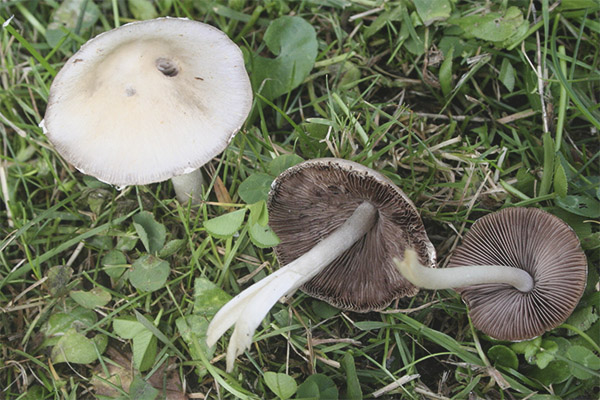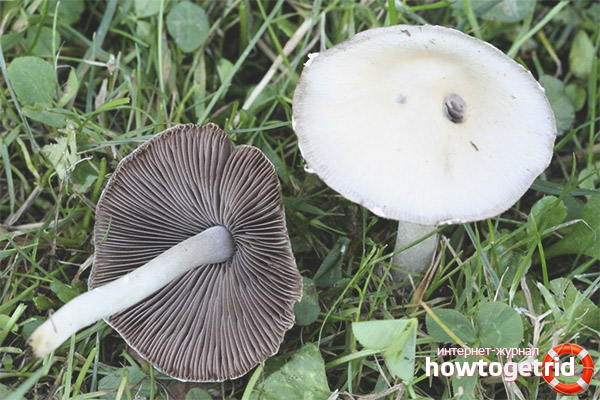The content of the article
Psatirella is ranked among the family of psatirellic and the genus of psatirella. About the edibility of the fruit bodies of this variety has long been debated. Some consider them unsuitable for eating, others refer to the type of edible conditionally. The second option suggests that with a long and thorough heat treatment, specimens can be tried. However, experienced lovers of quiet hunting are not advised to collect this variety, so as not to risk it.
Description
- Psatirella Candall is considered conditionally edible fruit body, as mentioned earlier. The tip of the diameter grows up to 10 cm. Maximum, is painted in beige or cream tone. It is fragile, it changes with its life cycle, becoming not round, but almost flat. Young specimens are sometimes endowed with a scaly brown structure. The edges of the tops are uneven, wavy, all in cracks. At the center of the hat there is a mound.
- The plates on the back of the hat are located next to each other, they stick to the base and are pigmented from light to dark brown. It all depends on the age of a particular fruit body. Leg height grows to 10 cm, it is smoothed and white. May be brownish in rare cases. At the bottom of the seal is noticed. The leg itself is weak and often breaks.
- The soft part of the whole fungus is painted whitish. From it comes a subtle scent. This type of mushroom has a twin, which is called brown-gray psatirella. This double is dark, grows next to the trees in the grass. Candol mushroom is not used in folk medicine. It has other names, such as fragile or foxfish.
- Growth begins from the end of the spring season and lasts until mid-autumn. The nature of growth is colonial in nature, but the group is not too voluminous. Search for mushrooms is necessary in North America and Eurasia. Fruit bodies grow directly on tree trunks and stumps. Often found in larch, as well as park areas, courtyards and gardens. The heat treatment after harvesting is very complex, so the fungus is practically not consumed in food.
Differences
- This species has distinctive characteristics. The cocoon that remains after birth is on the hat of the fruiting body. If there are no these remains of the veil, then it is necessary to study the place of growth. Mushrooms settle on dead parts of trees, in particular on stumps. Also on the ground there is no ring.
- If you compare Candolla, for example, with Agrotsibe, you should say the following. In our species, the spore powder is more darkened. And this variety differs from other psatirell in its large dimensions and light tone.
- Also, one cannot overlook the peculiar variability of Candoll. External data can be modified depending on climatic conditions, temperature conditions in the morning and evening hours. Equally important is the age and habitat. But you should know for sure that you will not confuse this species with edible mushrooms.
Water-loving psatirell
- This type of fruit has a cap in diameter of not more than 7 cm. Often it can be painted in light brown or yellowish color. Also on it you can see a small bump. The cap in most cases has a cracked structure and jagged edges.
- The mushroom is shaped like a bell. When the fruit body is aging, the hat becomes almost flat. To the touch it can be said that it is smooth and dry. The leg in height can reach up to 11 cm. It differs in a brighter color, unlike a hat. The leg is hollow, curved and rather dense. On the whole length there is a powdery deposit. To the touch it is velvety.
- As for the records, they are painted in a light beige color. After a sufficient amount of time, they acquire a brown tint. The plates are quite tight to the leg. The flesh is brown in color. It is watery, thin and soft. The taste is bitter, and the flavor is almost none. As for the similar types, they are absent.
- In most cases, these mushrooms begin to bear fruit from late summer until the first frost. Most commonly found in North America and Eurasia. Also considered mushroom has several minor names. Often it is called a hydrophilic fragile and psatirella, a spherical psatirella, and a watery false sap.
The fruit body discussed is a rather interesting mushroom. Such an instance is very rare.In addition, depending on weather conditions, he is able to change his appearance. This mushroom is not recommended to eat. It requires special handling. There is also a high probability that you can rip off a poisonous or simply inedible twin.












To send